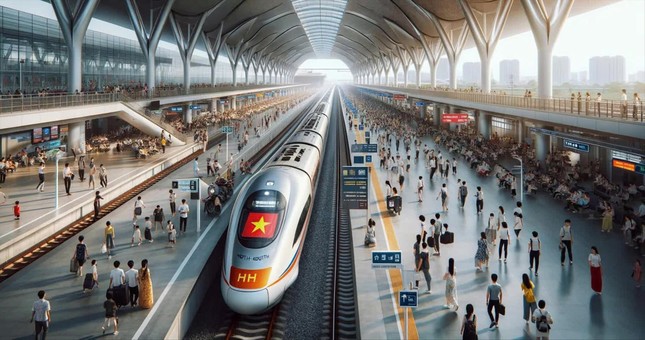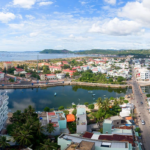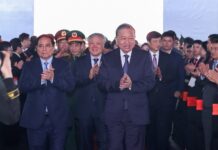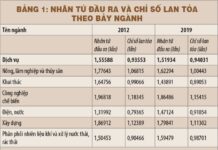One of the concerns in Vietnam today is the lack of high-speed railways, and the question arises as to how the country will fare in terms of construction, operation, maintenance, and, most importantly, technological mastery. The proposal presents a challenge of resource mobilization to encourage Vietnamese businesses (DN) to participate in building the high-speed rail system.

The proposal suggests forming a consortium of domestic enterprises to receive technology transfers.
Mr. Tran Thien Canh, Director of the Vietnam Railway Administration, stated that the experience of other countries shows that high-speed railways will enable a nation to establish a railway industry and engage large conglomerates. For example, South Korea received technology transfers from France and then engaged large domestic industrial corporations such as Daewoo and Hyundai to form a consortium, requiring the French supplier to sign a contract with this consortium for technology transfer.
In Vietnam, companies specializing in chips, electronic circuits, and automobile manufacturing, such as VNPT, Viettel, and Truong Hai, can participate. They can not only produce electronic components, accessories, and automobiles but also contribute to the railway industry’s auxiliary industries.
According to the proposal, the planned high-speed rail route between the North and the South is expected to have a structure comprising 60% bridges, 10% tunnels, and 30% ground. In terms of construction, the Vietnam Railway Administration leader believes that, based on the experience of building the North-South Expressway, building bridges and tunnels requires advanced techniques, and domestic enterprises are now capable of handling 100% of the design and construction.
Regarding the trains, Vietnam has already upgraded all old carriages into high-quality ones, and there are two railway industrial facilities: the Di An Locomotive Factory and the Gia Lam Locomotive Factory, established during the French period and now equipped with modern machinery and equipment, including CNC cutting machines. Some iron and steel companies have expressed their ability to produce rail steel if given the opportunity.
The rail and switch points are more complex than the rails, but if the market demand is large enough, domestic enterprises can participate in researching, producing, and supplying them.
The most complex aspect is the information, signaling, and train control systems, for which there are only a few manufacturers globally, such as Hitachi (Japan), Alstom (France), and Siemens (Germany). Even China has only achieved over 80% self-sufficiency and still relies on core technology providers.
In a conversation with Tien Phong, a Ministry of Transport (MoT) leader stated that one of the requirements for the high-speed rail project is for Vietnam to have complete technological mastery (including operation, maintenance, and repair) and gradually produce some components. After consulting the experiences of 22 countries worldwide, especially the six countries with the most developed high-speed rail systems today (Japan, France, Spain, China, Germany, and South Korea), several nations expressed their willingness to transfer technology to Vietnam.
To facilitate the participation of domestic enterprises in the development of the railway industry, the MoT proposes creating a special mechanism in the proposal, allowing the investors of high-speed rail, national rail, and urban rail projects to require general contractors and technology transfer from contractors. Additionally, investors can order means of transport and equipment that can be produced domestically from local businesses.
Along with this, there will be conditions for technology transfer and training in operation and maintenance for five years, with a consortium of local enterprises assembling about 30-40% of the carriages supplied. Simultaneously, railway industry products, supplies, and equipment that need to be prioritized will be added to the list of key mechanical products in the strategy for developing Vietnam’s mechanical industry to serve as a basis for preferential policies.
The proposal also suggests forming a consortium of domestic enterprises to receive technology transfers, conduct research and development, master operations and maintenance, gradually produce components and replacement equipment, and assemble and manufacture new carriages.
“If provided with suitable technology transfers, Vietnam has the potential to develop its railway industry, gradually master and localize the manufacturing of carriages, power supply systems, information, and signaling systems, and achieve complete autonomy in operations, maintenance, and producing replacement components for high-speed rail,” said a MoT leader.
Allocating over $400 million for human resource training
Ensuring a skilled workforce to operate the high-speed rail system is another challenging aspect of the project. According to the MoT, the proposal includes a training program for human resources in three forms (domestic, overseas, and combined domestic and overseas) with four qualification levels (technicians, engineers, masters, and doctors) for five subjects (state management agencies, project management units, operating units, training institutions, and research institutions).
The training will be funded by the project, with a total budget of approximately $348 million. Of this, the project operator will borrow about $340 million to train 13,880 personnel in management and operations and about $8 million to train 700 project management personnel.
Additionally, the proposal suggests allocating approximately $88 million from the project’s budget to train personnel for state management agencies, lecturers, and scholarships for students in specific fields such as metallurgy, mechanical engineering, electronics and telecommunications, automation, and artificial intelligence. It also includes building a shared laboratory to serve training, research, and development.
According to the MoT, after the construction is completed, the Vietnam Railway Corporation (VNR) is expected to be the unit responsible for managing, operating, and exploiting the entire infrastructure. They will be handed over all means of transport and equipment for exploitation and will be responsible for repaying the investment costs. As per the plan, the VNR will form two enterprises: one for management and business and the other for receiving investment means from the project for transport business.
The VNR leader stated that the enterprise is planning to prepare the necessary resources to manage and operate the high-speed rail system. Once the proposal is approved for investment, the corporation will select some management staff and lecturers from the Railway College to undergo training first, followed by others. A training roadmap has been developed according to the project’s implementation progress, and the training duration will vary depending on the position and responsibilities.
“The most time-consuming training is for train drivers. The VNR will select young train drivers with experience in operating conventional trains for training first. The entire line will require more than 700 drivers, but they will be trained in batches according to actual needs,” the VNR leader said.
Exploring the Ban Gioc – Detian Falls Today: A Guide to Experiencing This Majestic Landscape
As of today, October 15th, the symbol of cooperation between Vietnam and China is officially in motion.
The Southeast Asian Tiger: Unlocking Opportunities in Vietnam’s Dynamic Economy
A Southeast Asian tiger, Vietnam has proven its economic prowess, attracting over $7 billion in investments during the first nine months. Now, this dynamic nation sets its sights on collaboration with Ba Ria-Vung Tau, unlocking new avenues for growth.
Recently, Mr. Pham Viet Thanh, Secretary of the Provincial Party Committee and Chairman of the Provincial People’s Council of Ba Ria – Vung Tau, had a meeting with Mr. Pang Te Cheng, Consul General of Singapore in Ho Chi Minh City.




















